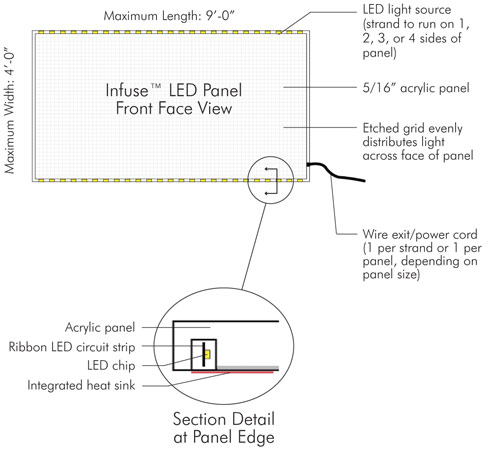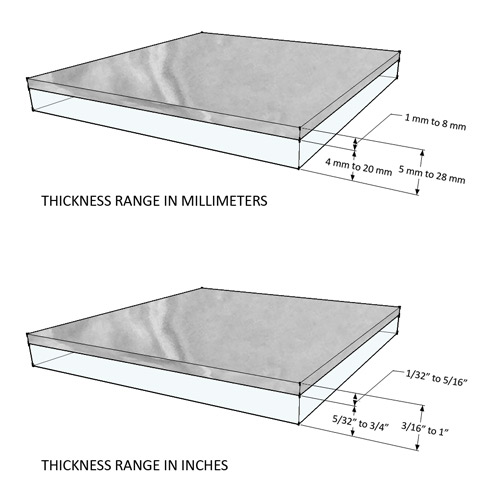Detailing FAQ
Toggle through our frequently asked questions to get answers on our backlit systems, process, guidelines, and product-specific questions.
Working with GPI Design
As designers entrust us with the concept for their backlit feature, we then carry it through design development, engineering, fabrication, shipment to site, and full installation. We most commonly work with architects, interior designers, and lighting designers in the concept phases of their projects. In those early phases we can help with cost analysis, recommendations for detailing, selecting a surface, and specifying our system. As the project progresses through the bidding process we coordinate heavily with the general contractor to win the award of the subcontract, then complete our full engineering, full fabrication, and see the feature through to construction.
In our turnkey scopes, we are handling the surface, structure, and lighting all together as one package. With these full scopes, here is an outline of the materials and services we provide:
- Supply of translucent surface (such as onyx, wood, glass, resin, fabric)
- Supply of backlighting system, wiring, and controllers
- Development, mock-up, and schematic drawings of backlighting system
- Full structural engineering detail drawings and calculations
- Fabrication of all components
- Coordination with general contractor and subcontractor for installation preparation
- Full installation of surface panels, backlighting system, and structural elements
With less complex applications we may, for example, simply supply the lighting or the surface, but our real passion is integrating the two.
Because the natural stone and wood materials we use vary so much from slab to slab / flitch to flitch, over our 18 year history we have found that stocking samples has only gotten us in trouble in using samples for material selection purposes. We don’t stock any type of material, either for production or sampling purposes. That allows us to find the best surface material for each project – discovering a match that the client loves, ensuring it is available in the right sizes and quantity, has the right translucency levels for the lighting environment, etc.
Often companies will buy bundles in bulk and stock those materials in a warehouse, making your selection limited to what they have there in that building. We don’t like to be hindered by what’s “in stock”, so for every project, we will actually send our geologists to several sources around the world to find the stone for you. We often source extremely rare varieties, not something readily available in a catalog – we don’t like to be hindered by those kinds of parameters. Mother Nature has so much to offer, and we think she is ultimately the best source for finding the perfect material!
The best way to evaluate our materials is via high resolution photographs and then at mock-up with the appropriate backlighting design. For specific cases, we may have small leftover pieces of materials that you can borrow temporarily. To begin to discuss the material selection process, share your design intent with us and we can strategize together.
To begin working with us, get in touch and one of our designers will work with you to address specific questions and move the project forward.
Detailing + Integrated Systems
Overall assembly depth depends on the translucency of the surface being backlit, amount of available space, necessity of diffusers, and support method.
We find it important to consider the surface in conjunction with the light source so that all hot spots are eliminated. Our designers sometimes specify the Flat-Lite™ LED panels to be placed directly to the back of the surface being illuminated but sometimes they’re placed up to 3″ behind. If you have limited space or highly translucent surface, GPI has several light diffusion strategies that can help eliminate hot spots and blend the light.
GPI performs physical testing and trials to determine the ideal lighting cavity for each project. Just send surface selection, specifications, samples and drawings and we can begin to develop your custom solution.
If you would like to take a look at how we detailed specific backlit features, download our case studies.
We deliver fully integrated systems of floors, ceilings, walls, curtain walls, reception desks, and bars, so the structural requirements vary with each application.
GPI engineers and fabricates a custom structural system per project. Methods include: structural steel angles, extruded aluminum, z clips, stand-offs, wood framing, suspended systems and hidden rear mounted supports.
Our structural systems seamlessly integrate the translucent surface with the LED backlighting: eliminating structural shadow lines to properly showcase the illuminated surface, allocating room for wiring and possible light diffusers, and holding both the surface and the light in proper relation to one another for maximum lighting performance. On the finish surface, the hardware of the structure can be expressed or concealed, depending on the design intent.
Send us your drawings and we can provide insight into the proper structural or fastening system for your project.
Product: Infuse™ Complete LED Backlighting System
Infuse™ Flat-Lite™ LED panels feature embedded energy-efficient, high output LEDs along the edges of an 8 mm (5/16″) acrylic panel. Laser-etched channels distribute light across the face of the flat panel, providing uniform light distribution for seamless backlighting of translucent architectural surfaces.

GPI does not stock sizes – we custom manufacture all our Infuse™ Flat-Lite™ LED panels per order. Contact GPI with architectural drawings for guidance in sizing LED panels. We base our recommendations on panel size(s) of surface material being backlit, amount of wire exits per panel, total electrical load on the power supplies, intended brightness levels, and ideal panel proportion for even light diffusion. We will also recommend on how many sides of the panel the LED strings should run: 1, 2, 3, or all 4.
Infuse™ Flat-Lite™ LED panels can backlight nearly any type of translucent surface, including natural stone, recycled glass panels, PVC stretch fabric, resin panels, acrylic, screens- anything that transmits light or is perforated.
Infuse™ Flat-Lite™ LED panels work well for illuminating feature walls, suspended ceiling panels, reception desks, bar countertops, stair treads, signage, and custom light fixtures.
We can engineer our Infuse™ Flat-Lite™ LED panels for exterior applications if certain conditions are met. Contact GPI for additional guidance on designing with LED panels in exterior environments.
We manufacture Infuse™ Flat-Lite™ LED panels in custom shapes and curved edges, but cannot thermoform or bend in three dimensions. For radius walls, LED panels can be faceted around a curve. GPI offers supplemental lighting methods to achieve even lighting on curved surfaces. Contact GPI for design consultation and detailing backlit curved forms.
Infuse™ Flat-Lite™ LED panels can be drilled in the field if holes occur at least 3 inches from the perimeter of the panel. We highly recommended that you contact GPI before drilling, as field alterations will void the product warranty. GPI can manufacture the LED panels with cutouts, special shapes, or sizes. Cutouts produced in the factory do not interfere with the product warranty.
GPI Design offers our Infuse™ Flat-Lite™ LED Panels in the following temperatures:
- 3000K
- 3500K
- 4100K
- 5300K
- Custom temperatures created per project with specialty diodes and/or gel filters
- Color changing RGB available
We recommend physical mock-ups to test the interaction between your particular surface and our Infuse™ Flat-Lite™ LED panels. Slight adjustments in the color temperature can bring out different characteristics and moods in your surface.
- Run multiple LED panels to dimming pack and set levels manually with a user interface screen on unit itself.
- Through a central building management system (BMS). Run multiple LED panels to the dimming pack and control brightness levels or set scenes through a BMS DMX-512 protocol system.
Optimal methods depend on the size of your application and level of control desired. Contact GPI for guidance on choosing a dimming option.
To calculate the approximate lifespan for your application:
70,000 hours ÷ days of use per year ÷ hours of use per day = lifespan in years
In addition, dimming the Flat-Lite™ LED panels with GPI’s Infuse™ Custom Dimming Packs can significantly contribute to increased lifespan by reducing the operating temperature of the LEDs and turning them off for certain periods of time.
- Flat-Lite™ LED Panels. Panel sizes, amount/location of LED strings, and standard vs. high output LEDs all affect price points. GPI can inform these decisions by knowing the type of surface being illuminated, color temperature of the lighting and intended levels of brightness.
- Power. Amperage determines pricing of power systems and can range from simple “plug-and-play” transformers, to our custom engineered power supplies with localized distribution, to high-capacity custom engineered power supplies with centralized distribution. GPI evaluates these options based on overall job volume and physical distribution throughout the building.
- Dimming/Control. Dimming and controls range from simple handheld remotes, to custom engineered dimming packs, to links with external timing devices. GPI arrives at these decisions based on desired dimming/control behavior and overall job volume. If your building is utilizing a central building management system (such as Lutron or Crestron), we can engineer our lighting to tie into that system.
- Diffusion techniques. If necessary, pricing is based on GPI’s recommended technique which depends on physical testing. Based on the brightness of LED panels, location and susceptibility of seams, surface illumination, and space available in which to cast the light, we will engineer the appropriate diffusion technique to blend the lighting into a seamless plane.
Send us drawings to request a custom quote for your project >
Product: DURA-Lite™ Glass-backed Translucent Stone Panels
DURA-Lite™ Glass-Backed Natural Stone consists of a thin layer of stone laminated to glass backing, with the stone serving as the outward finish face. Why do we use the glass backing?
- Light. Virtually any stone becomes translucent for backlighting applications when milled down to only millimeters and laminated to glass.
- Rigidity. Glass backing increases the rigidity of the thin stone layer, allowing for much larger and lighter panels. Larger panels results in less seams, fewer grout lines, and reduced installation times.
- Uniformity. Taking small slices from a single section of stone allow its unique pattern to be spread over a large surface area.

Read more here and download a packet that will help communicate your preferences.
To find matches for a stone a client has already approved, please send images of that stone and we can discuss finding a match. We will request that you send an image or sample of the stone, and not merely its name. Variances and name changes are rampant in the stone industry and the only way to verify a match is with visual comparison. After we find readily available stones, we will submit high resolution images for your approval. Then we begin to create DURA-Lite™ Glass-Backed Stone by laminating that stone to glass.
